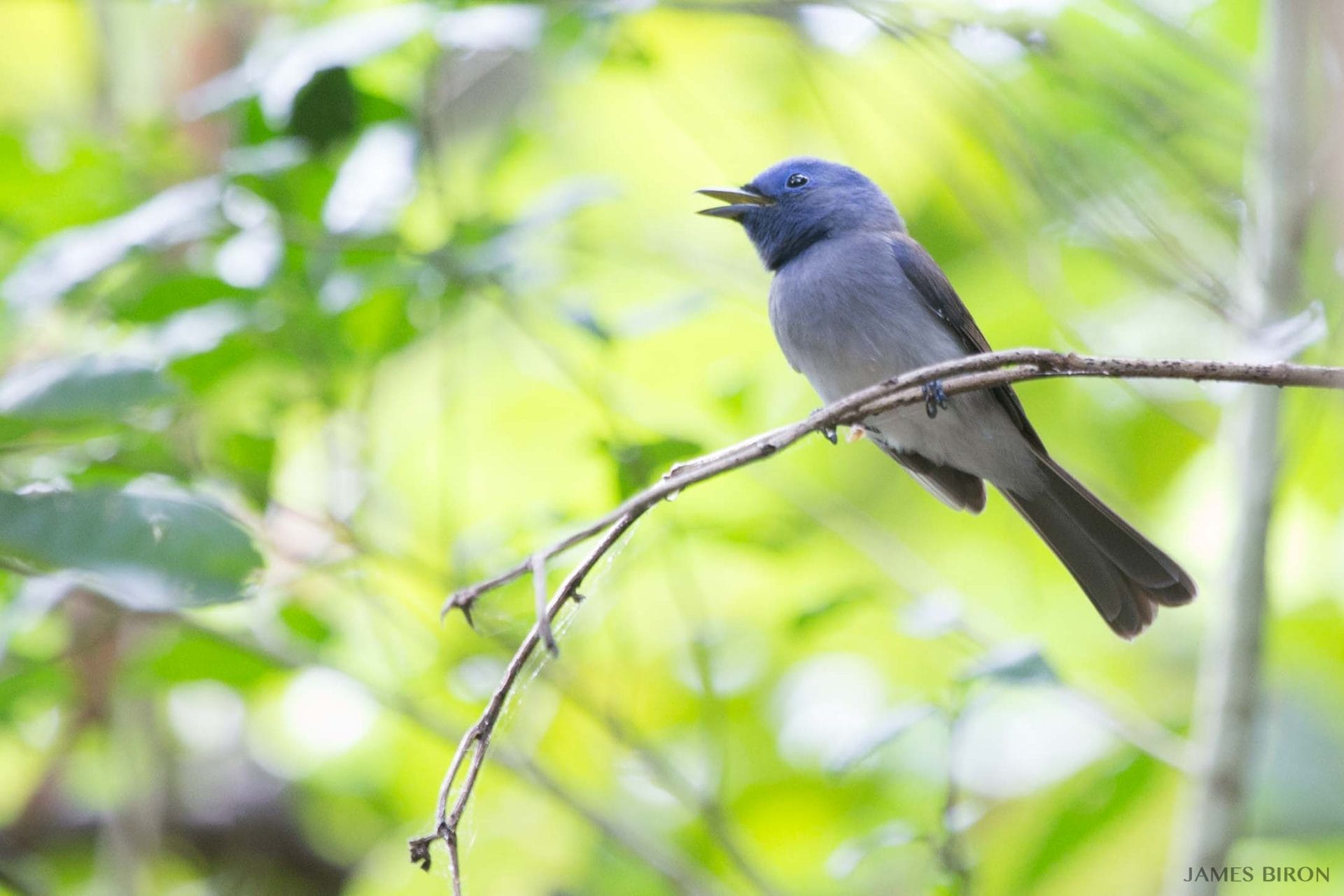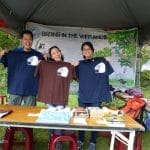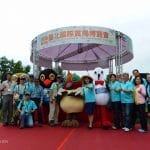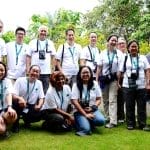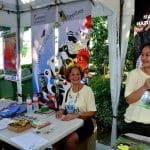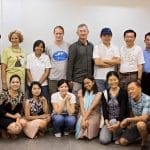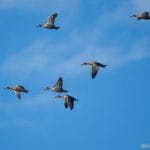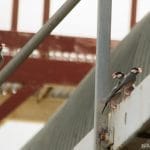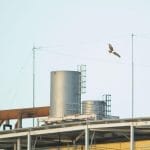October 31-November 1, 2015 – 6th Asian Bird Fair
Singapore Botanic Garden
Singapore
The 6th Asian Bird Fair was hosted by the Nature Society (Singapore), the last of the founding members to host an ABF. The two-day event held at the Botany Center of the Singapore Botanic Gardens was opened by Senior Minister of State Desmond Lee. Twenty two bird clubs, conservation societies and affiliates came to promote their country’s natural attractions and birdwatching activities.
The Nature Society organized a series of nature walks and talks to highlight this year’s theme: “For people, for nature, for future.” There was a Bird Fair Musical Performance on the opening day conducted by Dr. Robert Casteels. The highlight of the second day was a mini-bird race to see which team can see the most number of birds within 90 minutes.The Turnover Dinner on the last night was a more formal event where ABF Execom Victor Yu formally announced Cuncaoxin Rural Environment promotion Association will be the host of the 7th Asian Bird Fair in Jingshan County, Hubei Province (China) in November 2016.
Photo: Opening Ceremonies: Senior Minister of State Desmond Lee (left) receiving a token of appreciation from NSS president Shaun Lum and Willie Foo.

November 14-15, 2015 – 14th Thailand Birdwatching Fair
Thailand
Gina Mapua and Nikdye Realubit were supposed to travel on the 20th but flights to Bangkok were cancelled for APEC. Nik found a flight that left late on the 19th which meant they arrived in BKK at 230am. That gave them an extra day for sightseeing. Which they did!
They stayed at Karnmanee hotel on Pradiphat road. It was a good walk from the Saphan Kwai skytrain station. Very easy to get around Bangkok once you get the hang of their transport systems.
Just three observations from the sightseeing:
1. It costs 200Bht to get their stored value card called the Rabbit card. Of the 200, you get only 100 value, 50 of which can be refunded. Plus to reload, it’s 100Bht minimum. They have it easier on Philippines’ MRT/LRT system.
2. Family Mart has no twist all you can. Complete disappointment!!!
3. They have a wonderful river tour for 150Bht. You can hop on and off the boats all day and visit several piers on the Chao Phraya river. Nikdye and Gina were mesmerized by all the vegetables and flowers in the flower market area. Gina finally got to figure out what their water mimosa looked like.
And it looks like bicycle tours are becoming the rage. They even saw one group go through the skytrain system!!
Gina and Nikdye witnessed a few interesting developments in BCST and met some interesting and useful contacts at the bird fair.
ONE – BCST
They met up with Bang and Wichyanan who were with the club in Zamboanga. Bang is working on his masters.
They also caught up with Pu, who was their volunteer/translator at the 3rd Asian Bird Fair in Bang Pu. Pu now works for the Natural History Museum. Pu would have taken them on a private tour of the museum if it wasn’t closed on Mondays. They also met Gawin and Amorn.
BCST now has an Executive Director and a Conservation Manager. Executive Director is Nancy Gibson. She’s American-Thai and speaks Thai like a native. Conservation Manager is Tao Thattaya – also female. Boripat, who served as VP to Amorn, is now chairman for the next 4 years.
TWO – EEAFP
They met up with Tomoko Ichikawa, Communications Officer of the East Asian-Australasian Flyway Partnership. They found out Anson Tagtag is the country link to the EAAFP. Tomoko gave a very educational talk about the EAAF. She says the most effective educational tool is information in the language of the country. Seems like they can come in and help with the translation of her materials into Filipino. Cool!
THREE – Love Wildlife
Across their booth was an NGO called Love Wildlife. Nancy Gibson is also the CEO of this group. Gina and Nikdye also met Maja Malaimal, a board member and Maria Kalita. They are working on educating schoolchildren about keeping wildlife. Unfortunately, keeping wildlife is not a crime in Thailand. Maja spoke of their efforts to get an MoU with the DENR counterpart but the current political status isn’t helping. They are quite impressed that the Philippines have a Wildlife Act.
Their focus is on the slow loris. Plus they conduct whale watching to reduce the number of people going to dolphinariums. Hmmmmm, not sure if this is the route to go. lovewildlife.org
FOUR
Also across their booth was another NGO called Freeland that has an app called Wildscan in which you can report wildlife trading anywhere in the world. They met their CEO who failed to give Gina his card. But Gina has their flyer. They don’t have much data on the Philippines. Their system seeks to alert the local authorities whenever a report comes in through their pipelines. Gina thinks Nikdye got more info on this one.
Plus Gina seem to remember mentioning Emerson Sy and his work, and promising to send them Emerson’s paper.
They also plan to go to Palawan next year to check on wildlife trading there. freeland.org
FIVE – MNS
The Malaysia Nature Society booth was right next to them. Gina and Nikdye noticed they published a bird checklist of Malaysian birds. It sold well! Maybe the Club can print its own?
Something for the records committee to look into. To raise funds to print that Kennedy annex Mads suggested.
SIX – other attendees and non-attendees
They didn’t see representatives from the ARRCN, Taiwan, Taipei or any of the Chinese clubs. Paul Insua-Cao represented the Royal Society for the Protection of Birds. There was also a booth for the Oriental Bird Club but the people were BCST members. BANCA was well represented by 3 people. plus WWF and many Thai NGOs. They even had a booth specifically for origami. They knew how to fold several designs but their folds weren’t crisp and neat. Different style altogether.
SEVEN – merchandise
They sold all the notebooks, most of the buttons/pins and half of the T-shirts. Their T-shirts were priced at 300Bht. Neighbors sold theirs for 250Bht. Theirs were much thicker and prettier. In addition, there were several other booths selling their T-shirts.
One particular standout was called NatureToons. She’s on Facebook. Every educational! Unfortunately, only in Thai. She had various postcards, one of which had a drawing of a tuko. It said, “Don’t hit me.”
She also had a kid’s T-shirt that showed a tree and several birds. Each bird had text describing their role in nature. She gave Gina lots of ideas for developing the club merchandise!! https://www.facebook.com/naturetoon/?fref=ts
EIGHT – Next Thailand bird fair
Gina thinks it will be held again at the Queen Sirikit Park. Which is good. The park is RIGHT NEXT TO CHATUCHAK WEEKEND MARKET!!!!
NINE – BCST volunteers/translators
They had excellent Thai volunteers who quickly picked up on the work. MNS and WBCP were especially lucky as their volunteers were the children of a BCST member. So Fay and Fairy Subphachaisirikul stayed with them all the time. And the name of their younger sister? Pixie. They also met the dad and mom. Such a lovely family!
TEN – birding at the Queen Sirikit Park
The star bird was the hooded pita. Gina and Nikdye saw footage of the bird that seemed to be pecking away at one small spot. Probably baited. (Photo credits: Gina Mapua, Sirakorn Kumwongwan, Senkethya Sar)
November 17-20, 2015 – Club Trip to AES Power Plant
Masinloc Zambales
The club was invited to do a follow up ocular at the complex of the AES Powerplant in Masinloc, Zambales. The last trip held there, at that time also at the invitation of AES, was in 2011. At that time, 51 species were spotted.
Five members of the WBCP joined this trip, Jops Josef being the only one who was also there in 2011 for the previous trip. Other members were Harry Miller, Lowell Lorenzo, Douglas Ball and Willem van de ven. They were joined by Roland Allen Sumangue of the AES foundation, the local NGO to promote and execute the Corporate Social Responsibility program of the company.
The trip was well organized, from pickup in Manila and QC on Tuesday, with overnight stays at the Potipot resort, trips to different places in Masinloc together with local NGO, PO and barangay officials, all the way to delivery back home on Friday. A perfect week of avoiding the hectic APEC traffic madness in Metro Manila.
The first day was spent mostly in the van, traveling to Masinloc, where the group arrived around dusk. After the introduction video on safety guidelines for their trip, they had a dinner and an early night’s sleep, as they would be up before dawn on the day after. They birded on Wednesday at the plant facilities, around the barracks and the forest patch around the place. A swarm of Lowland White-eyes, numbering more than 200, passed them by in smaller flocks of 10-20 each, moving along the mangrove trees between the plant and the bay. White-breasted Wood-swallows sore over the facility and perch on the highest buildings, while Brahminy kites make regular appearances flying overhead, and are known to nest near the ashponds.
It can be seen that it is still a secondary growth forest which is growing up and will be much better forest in a few years’ time. This can also be deducted from the bird species composition, which has a lot of edge specialist and open area species (Philippine Coucal, leaf warblers, flowerpeckers, doves etc), with a few forest birds, such as the Pink-necked Green Pigeon, Philippine Bulbul and the Grey-streaked Flycatcher.
Unfortunately, they were just a few weeks too late for the ashponds, which are completely dried out by now. Up to November there is usually water in the ponds, and a resident population of Philippine ducks, however at this time they saw no more than Pied Bushchat, Scaly-breasted Munia and lots of Yellow Vented Bulbuls. In the area around the ponds is more secondary forest, with Black-naped Orioles, Pied Trillers, Red Turtle Doves and Island Collared Doves. One small pond, the so called Ash-lagoon, still had water, and they spotted a Common Kingfisher there, as well as a Barred Rail, before the rain put an end to the days birding.
On Thursday they took a boat to the protected area of San Salvador Island, a small mangrove island with some mudflats around it. A number of Great Egrets mingled with Little Egrets and a solitary Intermediate Egret, and several Whimbrels were seen around. Of course lots of White Collared Kingfishers are calling from all over the place. And there they saw them again, flying out from somewhere in the interior of the island, around 100 Philippine Ducks, making a circle and flying around before landing again. An attempt to reach the interior and see the ducks up close proved futile, as the mangrove vegetation is thick and dense, and only resulted in two pairs of broken slippers.
The group also visited a small river where the ducks are sometimes spotted, though they were not in residence at the moment. They did see and hear a lot of Flowerpeckers in the mangroves along the river, both Bicolored and Pygmy, and again several times a Brahminy Kite flew over, at one point flushing out an immature Black-crowned Night-heron. Around dusk they visited an inland water reservoir, where another, smaller, group of ducks were swimming around, between more Great Egrets and one Little Grebe. When they left, hundreds of egrets flew overhead and they could hear them chattering away when night fell, along the mangroves next to the river where they roost.
The area seems well managed, and there is obviously a lot of cooperation between AES and the community. The birds seem at ease and less shy because they are probably not hunted, neither at the plant grounds nor in the vicinity. We counted a total of more than 50 species on AES grounds, and around 20 of those were not recorded previously, while others that were seen last time did not make an appearance this time, mainly species that would have been found near the ponds. Hopefully they will return in the rainy season. To reward ourselves for a job well done, they left very very early on Friday and snuck in a few hours of watching woodpeckers in Subic. By the time they were back home on Friday afternoon, the traffic was almost back to normal. The group hope to be asked again for another trip next year, and that they will include the forest rehabilitation project that they are implementing a bit further on, as that will certainly be an interesting area to survey. (Photo credit: Willem van de Ven)
November 28, 2015 – Club Trip to Masungi Karst Conservation Area
Tanay , Rizal
Club member Willem van de Ven reported that a second trip to the Masungi Karts Conservation area proved a good idea. Besides the karst area, they also got to bird around the clubhouse which is situated in a forest patch near a stream. The group did not need to get far to get some good birds. Highlight of the day was the mixed flock in the canopy of a tree right next to the clubhouse, where Orange-bellied Flowerpeckers and a Brown-throated Sunbird were seen along Red-keeled Flowerpeckers and a Narcissus Flycatcher!
They managed to start earlier that day, and were greeted by a male Blue Rock Thrush right at the entrance, on the roof of the guard house. The group split in two; Brian having decided that he need not again lose 3 pounds on a morning bird walk 🙂 So he, together with Linda, stayed in the forest patch near the clubhouse, while Nikdye, Russell and Willem went back to the area they birded before, joined by Ann Dumaliang of the development corporation who organized the trip. They were on top of the hill at the start of the trail at 6:20 and the weather was cool and cloudy. They walked to the viewpoints immediately as they thought to have the best chances of birds there, before it got too hot.
With a bit of drizzle, they mostly heard birds instead of seeing them, until the sun came out around 7:30 and they had gorgeous views of the valley below. They could hear a number of Luzon Hornbills in the distance, and pygmy woodpeckers and an Amethyst Brown Dove nearby.
The area has a number of attractions for adventurists that are not birders, such as the spiderweb they visited last time. This time they climbed a sort of hug hammock spanning between two rock formations, effectively creating a (very wobbly) canopy walk/crawl. This is extremely relaxed birding, and after hanging around for a while, a number of Black-naped Monarchs were foraging right underneath them. It took them a while to figure out what the small black bird with white splotches on its back was, until they finally got a look at the side of the Elegant Tit (a Splotchy Tit! 😀 )
When they came back to the clubhouse around 11 am they still got to see the mixed flock that Linda and Brian had been observing for a while, before making their birdlist together and going back home around noon. They are welcome back there, and perhaps set up a quarterly monitoring of the area. There is a basic dormitory nearby where they can even stay overnight next time to get an early start.
In total they got a list of 29 birds this time, plus 4 other taxa. Combined with the previous trip this makes 36 species and 7 other taxa around the place. (Photo credit: Willem van de Ven)
November 29, 2015 – Guided Trip to UP Diliman
Quezon City
The guided trip pushed through despite the road blockades in UP Diliman. There was a group of about 15 Mensas guided by Gina Mapua and Christian Perez.
November 29, 2015 – Ocular Inspection at Terrazas de Punta Fuego
Nasugbu, Batangas
Club member Karen Ochavo reports that the site visit and initial bird survey pushed through today at Terrazas de Punta Fuego, Nasugbu, Batangas, with me, Maia Tañedo and James Biron. This visit was requested by Terrazas through Mr. William Gonzales because their management is planning to make the property a nature sanctuary and thinking of putting up signs about the wildlife that can be seen there. They also had a plant survey there recently with the Philippine Horticulture Society.
The group arrived there around 10:30am and started birding a few minutes later at the nature trail which is at the southern end of the entire property. The nature trail is a paved walking/jogging path, roughly 1 km, which is mostly parallel to a creek that drains west into the sea. The nature trail is part of the buffer zone between the creek and the adjacent sloping residential lots. The vegetation along the nature trail is undisturbed secondary forest which has a lot of promise. They spent about 2.5 hrs there, taking our time to show William all the birds they could spot since it’s his first time to go birding. The highlight there was the 6 (yes, 6!) Black-naped Monarch that were not shy! They also saw a lone Mangrove Blue Flycatcher, several Philippine Bulbul, and the more common White-collared Kingfisher and Philippine Pygmy Woodpecker among others.
They really appreciate the late lunch prepared for them —traditional “binalot” rice meal with adobo and shrimp in extra-large size for each of them! Perfect recharge right after climbing up the steps at the end of the trail. After our hearty meal, they rested while William shared some info about the development of Terrazas and its surrounding environment. Also learned a Tagalog word I’ve never used before: “pagliwat” meaning “translate” 🙂
William had to go at 3pm so he left them by the beach where they chilled since the surrounding forest was quiet birdwise. But they still managed to spot 3 Black-winged Stilts flying overhead, seemingly confused which direction they should go. By 4pm they theynt to the open amphitheater with surrounding grassy area north of the property but not a lot of birds save for some swiftlets and swallows. they started our journey back to Manila by 5pm, with one quick stop to watch what Maia called the ‘watercolor sunset’ at the lookout right before the Nasugbu-Ternate tunnel.
All in all they listed 25 species seen and heard. (Photo credit: Karen Ochavo & James Biron)


